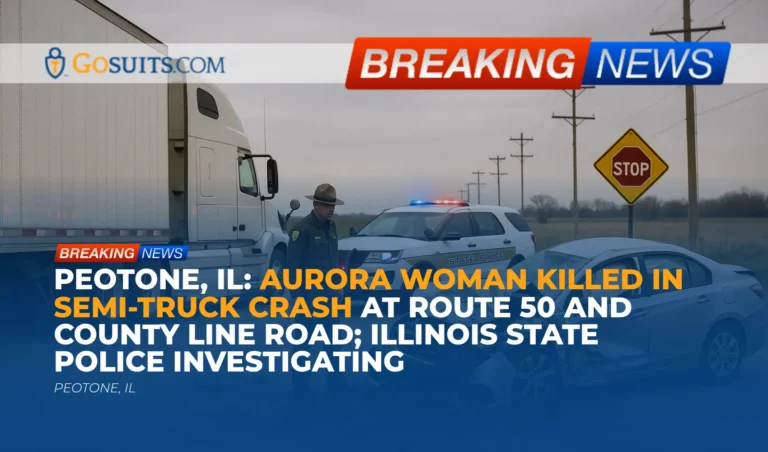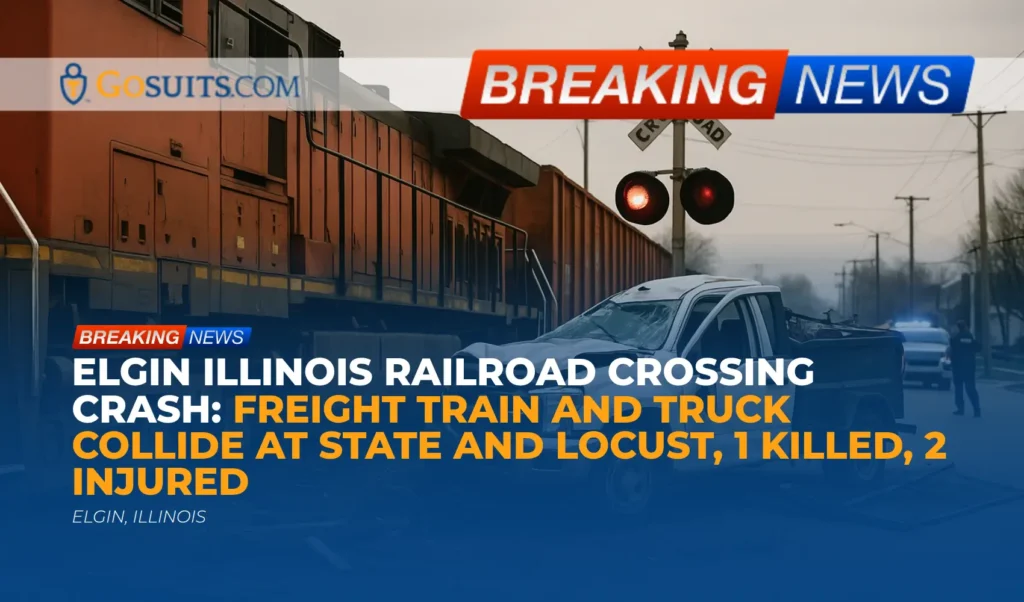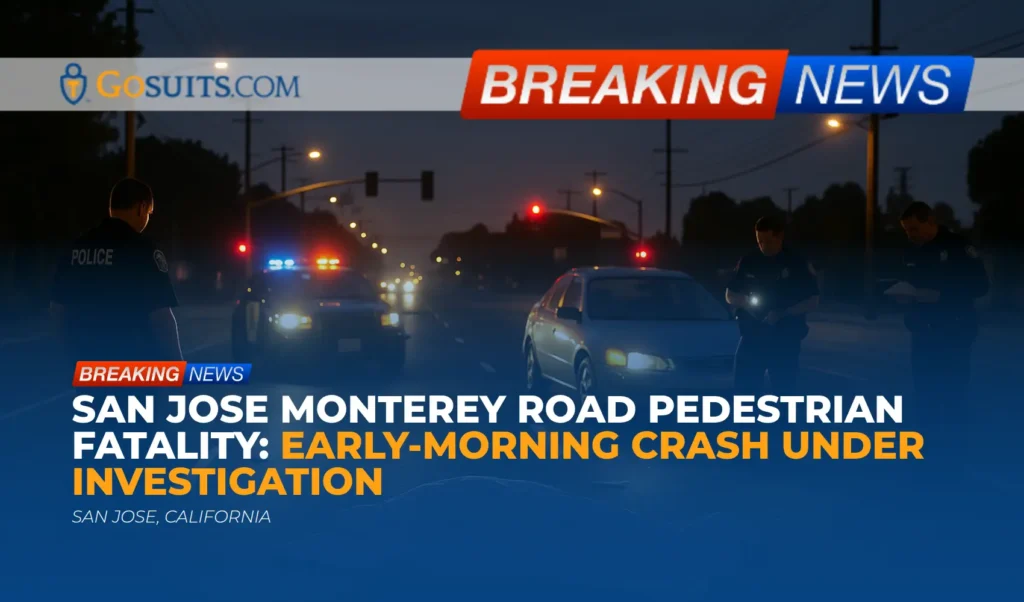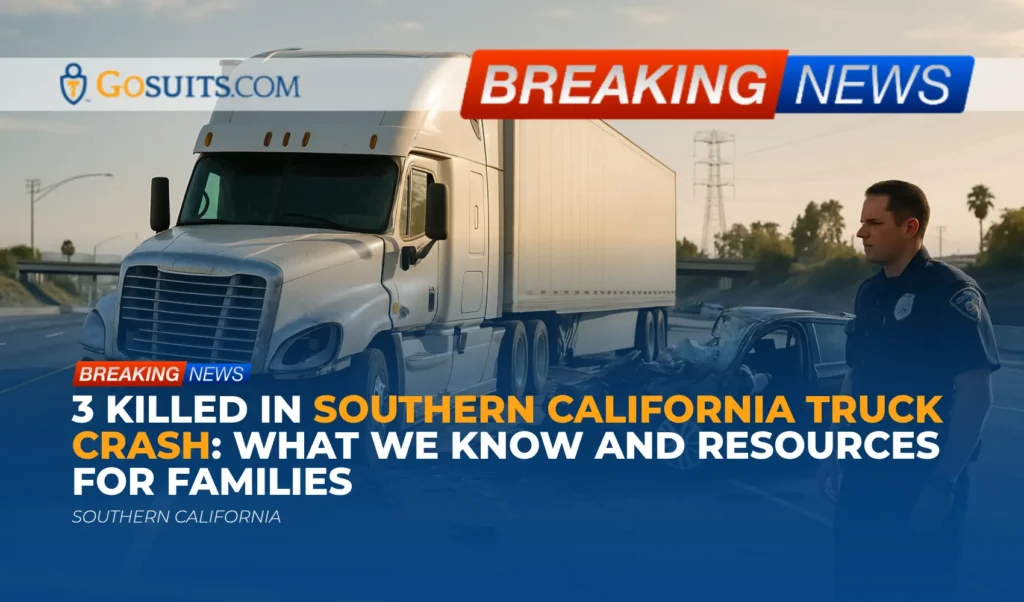- What we know about the Peotone collision
- Status of the official investigation
- How to obtain official records and information
- Potential civil claims after a fatal truck and passenger vehicle crash in Illinois
- Key evidence to preserve in a semi-truck collision case
- How insurance coverage can apply in mixed passenger vehicle and semi-truck crashes
- Wrongful death and survival actions in Illinois, time limits and damages
- Safety context for rural intersections and large trucks
- Support resources for bereavement and crisis
- Sharing information with investigators
- Commentary from Gosuits Peotone, Illinois Personal Injury Attorney
- Why timely action matters now
What we know about the Peotone collision
Authorities in Will County have reported a fatal two-vehicle crash that occurred on Friday night at the intersection of County Line Road and Illinois Route 50 in Peotone. According to the Will County Coroner’s Office, a 35-year-old woman from Aurora was identified as the victim and was pronounced deceased at 9:50 p.m. on Friday, October 17, 2025. Officials stated she was a passenger in a vehicle involved in a collision with a semi-truck. A post-mortem examination was conducted on Saturday, October 18, 2025. The final cause and manner of death will be determined after toxicology and law enforcement reports are complete. The Illinois State Police are leading the investigation. Traffic on Route 50 in the area was affected Friday night during the emergency response.
As of this writing, investigators have not released information regarding the driver of the passenger vehicle or any potential contributing factors. It is normal for crash investigations involving serious injury or loss of life to take weeks as agencies collect evidence, complete scene analyses, and await laboratory results.
Status of the official investigation
The Illinois State Police (ISP) investigate serious roadway crashes and coordinate with local responders and the county coroner when fatalities are involved. In cases with large commercial vehicles, investigators typically gather driver statements, witness accounts, vehicle event data, dash or surveillance video if available, and device records such as electronic logging devices used by motor carriers. Toxicology results are standard whenever a fatality occurs, and reconstruction specialists may analyze skid marks, vehicle crush damage, and other physical evidence.
Families should expect staged updates. A preliminary crash report often comes first, followed by supplemental reports and, later, the coroner’s final determination of cause and manner of death. Reports sometimes remain unavailable to the public while the investigation is active. When they are released, access is generally through the investigating agency’s records portal or by a formal records request.
Learn more about ISP district operations at the Illinois State Police District pages and about crash reports at ISP’s crash report page. For general access to Illinois crash reports, refer to the ISP site at isp.illinois.gov/CrashReports.
How to obtain official records and information
Police crash report
Because this incident is being handled by the Illinois State Police, the primary crash report will be maintained by ISP District 5. When available, police crash reports are typically accessible through the ISP’s crash report system. Some reports may require a case number, driver name, date, and location to retrieve. Start at Illinois State Police Crash Reports and the District 5 page at isp.illinois.gov/Patrol/District5 for district contact and guidance.
Under Illinois law, certain crash report information is confidential and may be released only to parties with a proper interest. See Illinois Vehicle Code provisions on crash reports and their use, including confidentiality, at 625 ILCS 5. Section 11-408 addresses use of accident reports.
Coroner records and autopsy report
The Will County Coroner oversees post-mortem examinations and certifies cause and manner of death. Family may request records or updates directly from the coroner’s office. Start at the county’s official coroner page on the Will County website: willcountyillinois.com and navigate to Elected Officials then Coroner. The coroner typically releases preliminary findings and, after toxicology and investigative inputs, a final report. Illinois law addresses coroner duties in the Counties Code at 55 ILCS 5.
Death certificate
A certified death certificate is issued by the local registrar and the Illinois Department of Public Health (IDPH). Guidance for requesting death records is available at IDPH’s Vital Records page: dph.illinois.gov/topics-services/birth-death-other-records/death-records.html. Funeral homes often assist with the initial certificate request, and certified copies are typically needed for insurance and estate matters.
Traffic signal, roadway, and engineering data
For intersection configuration, signage, or crash history, the Illinois Department of Transportation (IDOT) maintains crash facts and traffic safety resources. See IDOT Crash Facts and Statistics. Engineering or maintenance records for Illinois Route 50 may be requested from IDOT through its public records processes, subject to the Illinois Freedom of Information Act.
Public records requests
When certain records are not available through standard portals, Illinois’ Freedom of Information Act can be used to request public records from state and local agencies. For statute text and exemptions, see 5 ILCS 140. Agencies post FOIA instructions on their official sites, including addresses for submitting requests and expected processing timelines.
Potential civil claims after a fatal truck and passenger vehicle crash in Illinois
When a fatal collision involves a passenger vehicle and a semi-truck, several civil liability questions arise. The answers depend on the facts developed through investigation. Without speculating about this case, the following issues commonly matter in Illinois fatal crash evaluations:
- Driver negligence. Civil liability often turns on whether a driver failed to use reasonable care. Examples include inattention, improper left turn, failure to yield, speeding, or disregarding a traffic control device. Illinois uses a modified comparative negligence framework for assessing fault among parties.
- Commercial carrier responsibility. If a semi-truck driver was working, the motor carrier can be responsible for the driver’s negligence under vicarious liability principles. Additional claims may involve negligent hiring, retention, training, supervision, or maintenance. Federal motor carrier regulations set safety baselines for drivers and carriers, including hours of service, vehicle inspection, and recordkeeping. See the eCFR for hours of service at 49 CFR Part 395, driver qualification files at 49 CFR Part 391, and inspection and maintenance at 49 CFR Part 396.
- Vehicle and component failures. Braking systems, tires, lighting, or steering issues may be relevant. Investigators often review maintenance logs and inspection records that carriers are required to keep under federal regulations.
- Roadway design or traffic control. Sight lines, signage, signal timing, and surface conditions can factor into crash causation. Claims involving public entities have unique notice and timing requirements. See the Local Governmental and Governmental Employees Tort Immunity Act timing rules at 745 ILCS 10/8-101.
- Third-party liability. Depending on the facts, entities such as shippers, brokers, or maintenance contractors may be implicated. This determination generally follows document review and expert analysis.
Illinois recognizes separate civil causes of action after a wrongful death event, discussed below, which allow surviving family and the decedent’s estate to seek compensation for legally recognized losses under state statutes.
Key evidence to preserve in a semi-truck collision case
Evidence preservation is critical in cases involving commercial vehicles. Much of what determines civil liability resides in records controlled by the motor carrier, the electronic systems on vehicles, and government-held data. Preserving this material early helps ensure a full and fair investigation.
- Electronic data from vehicles. Passenger vehicles and many heavy trucks store crash-related information in an event data recorder. The National Highway Traffic Safety Administration provides technical information about EDRs at nhtsa.gov/research-data/event-data-recorder-edr. Retrieval should be done by qualified professionals to avoid data loss.
- Electronic logging devices and telematics. Carriers use electronic logging devices to record driving time and sometimes GPS-based telematics for fleet management. Federal regulations require carriers to keep driver logs and certain records for specified periods. See 49 CFR Part 395.
- Driver qualification and training records. These show licensing status, medical certification, road tests, and safety history. See 49 CFR Part 391.
- Inspection, repair, and maintenance files. Records related to brake inspections, tire replacement, and corrective actions are required under 49 CFR Part 396.
- Scene documentation. Photos or video of final rest positions, skid marks, debris fields, and roadway features, along with measurements from law enforcement reconstructionists, can be pivotal.
- Third-party video. Nearby businesses, homes, or traffic cameras may have recordings, which often overwrite quickly.
- Phone and device records. Call logs or usage data can be relevant if distraction is at issue. Access usually requires consent or legal process.
Because vital records can be lost to routine retention limits, a formal preservation request is often sent to the motor carrier and any other involved entities. This is sometimes called a spoliation or preservation letter. It typically identifies specific items to retain, such as EDR data, ELD data, driver logs, bills of lading, dispatch communications, and maintenance files.
How insurance coverage can apply in mixed passenger vehicle and semi-truck crashes
Insurance coverage in collisions involving both a passenger car and a semi-truck can be layered and complex. Understanding coverage types helps families anticipate which policies may come into play, without assuming any fault or outcome.
- Commercial motor carrier liability. Federal financial responsibility rules require for-hire interstate carriers to maintain minimum liability coverage, generally from 750,000 to higher amounts depending on cargo and operations. See 49 CFR Part 387.
- Personal auto liability. Illinois requires minimum auto liability insurance limits for passenger vehicles. These policies apply to at-fault drivers and may be supplemented by higher limits if purchased.
- Uninsured and underinsured motorist coverage. Illinois policies generally include uninsured and underinsured motorist coverage that may respond if an at-fault driver’s coverage is insufficient, subject to policy terms.
- Umbrella or excess coverage. Individuals and businesses sometimes have additional layers of coverage. These may be discovered during claim investigation.
- Medical payments benefits. Some auto policies include no-fault medical payments coverage for immediate medical costs, though amounts vary and availability depends on policy language.
Communications with insurance adjusters are often recorded and can affect claim outcomes. Before speaking with any insurance company about fault, injuries, or losses, it is prudent to consult a qualified attorney for a free consultation. Statements made early can be used later in ways that are difficult to unwind.

Wrongful death and survival actions in Illinois, time limits and damages
Illinois law provides two primary civil avenues after a fatal incident, each serving a different purpose. The specific facts of any case determine which claims are available and who may bring them.
Wrongful death claim
The Illinois Wrongful Death Act allows recovery for the benefit of the surviving next of kin for losses they suffer from the death. Covered losses can include loss of financial support and loss of society, among others, as determined by law and the facts of the case. See 740 ILCS 180. The action is brought by the personal representative of the deceased person’s estate on behalf of the next of kin. The statute generally requires filing within two years, subject to specific exceptions described in the Act.
Survival action
A survival action allows the decedent’s estate to pursue claims the person could have brought had they lived, such as damages for conscious pain and suffering, medical expenses, and wages lost between injury and death. See the Illinois Probate Act survival provision at 755 ILCS 5/27-6, and the general personal injury limitations period at 735 ILCS 5/13-202.
Claims involving public entities
When a public entity is implicated, there can be shorter time limits and notice requirements. For example, the Local Governmental and Governmental Employees Tort Immunity Act sets a one-year limitations period for certain actions against local public entities. See 745 ILCS 10/8-101. Different procedures apply to claims against the State of Illinois, which may fall under the Court of Claims. See 705 ILCS 505.
Because timelines can be strict and fact dependent, early evaluation is important so that families do not miss critical deadlines while awaiting official reports.
Safety context for rural intersections and large trucks
Rural intersections on state routes often combine higher speed limits, limited lighting at night, and complex sightlines due to terrain or roadside development. Large trucks require longer stopping distances and wider turning radii. National and state data reflect the risks that arise where heavy vehicles and passenger cars share the road.
- Large trucks and fatality risk. National Highway Traffic Safety Administration data show that crashes involving large trucks account for a meaningful share of traffic fatalities nationwide each year. See NHTSA’s traffic safety overview at nhtsa.gov/road-safety/traffic-crash-data.
- Illinois crash trends. IDOT publishes annual crash facts and statistics that break down crashes by location type, time of day, and vehicle class. Reviewing IDOT’s publications can help communities and policymakers understand patterns and consider countermeasures. See IDOT Crash Facts and Statistics.
- Engineering and enforcement. Improvements such as enhanced signage, rumble strips, lighting, and turn lanes are among engineering tools considered for high-risk intersections. Enforcement and education on right of way and speed compliance remain essential.
While it is too early to draw conclusions about this specific collision, understanding the broader safety context underscores why complete and careful investigations are so important for families and the community.
Support resources for bereavement and crisis
Grief after a sudden loss can be overwhelming. Compassionate support and accurate information help families navigate the first days and weeks.
- Behavioral health support. The national 988 Suicide and Crisis Lifeline is available 24 hours a day and can connect callers with local crisis resources. Learn more from the U.S. Department of Health and Human Services and SAMHSA at samhsa.gov/find-help/988.
- Victim assistance. State and county victim services can provide information about rights, available support, and navigation of the process following a fatal crash. The Illinois Attorney General’s Crime Victim Services resources provide state-level guidance at ag.state.il.us/victims.
- Practical documentation. IDPH’s death record resources at dph.illinois.gov explain how to obtain death certificates, which are often required for benefits and estate administration.
Sharing information with investigators
Community members who witnessed the crash, saw vehicles shortly before the impact, or have relevant dashcam or security footage can assist investigators. The Illinois State Police District 5 page at isp.illinois.gov/Patrol/District5 provides district contact information. When reaching out, include the date, time, location, and any case or incident number if you have it. Even small details, such as vehicle positions or traffic light status, can be helpful.
For families, it is often best to designate a single point of contact to communicate with agencies. Keeping a written log of calls, requested documents, and deadlines helps avoid missed follow-ups and duplication of effort.
Commentary from Gosuits Peotone, Illinois Personal Injury Attorney
We extend our sincere condolences to the family and loved ones of the Aurora woman who lost her life in this Peotone crash. This article is intended for educational purposes and general information, reflecting what authorities have publicly shared so far. Any next steps should be considered carefully in light of the evolving facts.
Based on the information available, this was a collision between a passenger vehicle and a semi-truck at a rural intersection, with the decedent riding as a passenger. Passenger positions can create unique challenges because the person most affected had no control over either vehicle. That is why a thorough investigation is essential. In our experience, cases involving commercial trucks often turn on time-sensitive evidence, including electronic logging data, maintenance records, and event data recorder downloads. Prompt preservation of these materials is crucial so that families are not left with unanswered questions.
Insurance companies and large transportation corporations manage claims every day, and they rely on systems designed to minimize payouts. Adjusters may quickly request recorded statements or medical and personal records before families have a full picture of what happened. Information shared in those early conversations can be taken out of context and used to dispute liability or reduce the value of losses. When multiple insurers are involved, each may try to shift responsibility to another party, which can further delay resolution.
Obtaining a free consultation before speaking with insurers can help clarify rights, deadlines, and practical steps to protect a claim. It also helps ensure that crucial evidence is preserved, appropriate experts are engaged when needed, and that communications with insurers are accurate and complete. The goal is to keep the process grounded in facts while protecting the dignity and interests of those affected.
Why timely action matters now

What to do
- Secure official documents. Obtain the police crash report from the Illinois State Police when it becomes available and request updates from the Will County Coroner regarding the autopsy and final determinations.
- Preserve evidence. Ensure that vehicle data, including event data recorder information, as well as photos, videos, and witness details, are identified and preserved before they are lost to routine deletion or repairs.
- Centralize records. Keep a single, organized file of medical, funeral, and related expenses, along with correspondence and claim numbers. This makes future submissions and reviews faster and more reliable.
- Speak carefully with insurers. Before contacting any insurance company about fault or damages, consult with an attorney for a free consultation to understand rights and obligations. What is said to insurers can be used later and may affect outcomes.
- Track deadlines. Note potential time limits, including those under the Illinois Wrongful Death Act and other statutes. Waiting for final reports is common, but it should be balanced against statutory deadlines.
Why acting now matters
- Evidence is perishable. Electronic logging data, in-vehicle recordings, and third-party video may be overwritten or destroyed by routine systems in days or weeks. Early preservation can be the difference between answering key questions and being left with uncertainty.
- Agency timelines. Police and coroner reports follow their own schedules. Starting requests early helps ensure documents are available as soon as they are released and that any necessary corrections can be addressed promptly.
- Insurance positioning. Insurers begin evaluating exposure immediately. Early, accurate information from the family’s side helps prevent mischaracterizations and keeps the process focused on verified facts.
- Legal time limits. Statutes of limitation continue to run while investigations proceed. Understanding applicable deadlines now helps avoid last-minute rushes and reduces the risk of missing a filing date.
- Emotional bandwidth. Grief makes administrative tasks difficult. Starting a simple framework for recordkeeping and communication can lower stress and help others step in to assist effectively.
Key public resources cited
- Illinois State Police Crash Reports
- Illinois State Police District 5
- Will County, Illinois – Coroner information
- Illinois Department of Public Health – Death Records
- Illinois Wrongful Death Act, 740 ILCS 180
- Illinois Probate Act Survival statute, 755 ILCS 5/27-6
- Illinois personal injury limitations, 735 ILCS 5/13-202
- Local Governmental and Governmental Employees Tort Immunity Act time limit, 745 ILCS 10/8-101
- 49 CFR Part 387 – Minimum levels of financial responsibility for motor carriers
- 49 CFR Part 395 – Hours of Service
- 49 CFR Part 391 – Driver qualifications
- 49 CFR Part 396 – Inspection, repair, maintenance
- NHTSA – Event Data Recorder
- IDOT – Crash Facts and Statistics
- NHTSA – Traffic crash data
- Illinois Freedom of Information Act, 5 ILCS 140
- SAMHSA – 988 Suicide and Crisis Lifeline






